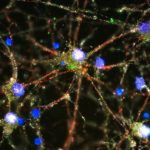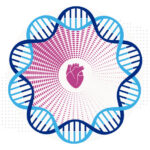Mutations during prenatal development may contribute to schizophrenia

Schizophrenia is known to have a genetic component, and variants in 10 genes have been identified as markedly increasing schizophrenia risk. But together, these genes account for under 5 percent of cases.
Now, a pilot study in the journal Science suggests another important contributor to schizophrenia: distinctive patterns of non-inherited (somatic) mutations. These mutations appear to have occurred as the brain was forming and affect just a portion of its neurons.
“Our findings suggest that prenatal mutational processes potentially contribute to a risk of schizophrenia later in life,” says Christopher Walsh, MD, PhD, in the Division of Genetics and Genomics at Boston Children’s Hospital. Walsh was co-senior investigator on the study with Andrew Chess, MD, at Mt. Sinai School of Medicine. “The mutations we found were channeled to particular sites in the genome, probably representing less than 1 percent of the genome.”
The researchers performed deep genomic sequencing of neurons in the prefrontal cortex of 61 deceased people with schizophrenia and 25 controls. To capture easy-to-miss somatic mutations, they completed 239 overlapping DNA reads. (Standard genomic sequencing typically involves 30 reads.) This work was led by Eduardo Maury, PhD, a neurosurgery resident at Boston Children’s and Brigham and Women’s Hospital, and bioinformaticians Attila Jones, PhD, at Mt. Sinai and Vladimir Seplyarskiy, PhD, at Harvard Medical School.
Subtle mutations, big impact
The somatic mutations preferentially affected transcription binding factor sites — parts of the genome where regulatory proteins bind to DNA and influence whether a particular gene is turned on or off. Walsh thinks that these mutations prevented transcription factors from binding and turning on genes essential to brain development.
“Our results indicate surprising specificity,” says Walsh. “The sites in the genome that are most important to forming the brain are precisely those most vulnerable to mutations.”
The team found two types of subtle genetic variants in people with schizophrenia. In one type, a cytosine-guanine (C-G) DNA base pair was flipped to become cytosine-thymine (C-T). The researchers think this was an error that occurred soon after conception, as chromosomes unwound to enable genes to be turned on. The other type, thought to be caused by oxidative damage, was a T to G mutation, in which guanine was swapped in for thymine at a specific DNA location. Both types of mutations are known to occur in cancer.
Some of the variants appear to have altered the expression of known schizophrenia risk genes or genes involved in neurodevelopment. “In some cases, unrelated patients with schizophrenia had the exact same base pair change at the exact same site,” Walsh notes.
Future schizophrenia agenda
What causes these mutations is unclear. The investigators think they may have resulted from a prenatal insult, such as a maternal infection or autoimmune reaction. How the mutations might produce symptoms of schizophrenia remains an unexplored mystery. Boston Children’s researchers have previously found a mosaic pattern of somatic mutations in brain tissue in autism spectrum disorder and epilepsy.
Walsh and Maury now want to confirm their findings in samples from larger numbers of people with schizophrenia and use more sensitive methods to detect very rare somatic variants. Such variants, while much less prevalent, contribute more risk when they occur.
“A vast amount of genetic causation is left unaccounted for,” says Walsh. “Understanding these mutations might also help us understand why schizophrenia may not emerge until late adolescence or young adulthood.”
Learn more about Genetics and Genomics and neuroscience at Boston Children’s Hospital and subscribe to our monthly research newsletter.
Related Posts :
-

Children with psychotic symptoms may merit genetic testing, finds study
A 6-year-old boy began seeing ghosts, aliens in trees, and colored footprints. More disturbingly, he heard voices coming from the ...
-

Genetic analysis backs a neuroimmune view of schizophrenia: Complement gone amok
A deep genetic analysis, involving nearly 65,000 people, finds a surprising risk factor for schizophrenia: variation in an immune molecule best ...
-

In the genetics of congenital heart disease, noncoding DNA fills in some blanks
Researchers have been chipping away at the genetic causes of congenital heart disease (CHD) for a couple of decades. About 45 ...
-

Making genome sequencing a first-line test in rare disease
Children with rare diseases often undergo years of medical visits and genetic testing before they get a diagnosis. Over the ...





